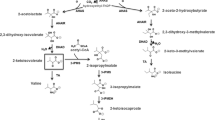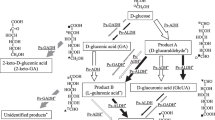Abstract
The strictly anaerobic, fermenting bacterium Pelobacter acidigallici degrades several trihydroxybenzene derivatives to stoichiometric amounts of acetate. We now report on the enzymatic activities in cell extracts which are responsible for the fermentative degradation of these aromatic compounds, and postulate a novel phloroglucinol pathway involving triacetic acid as an unusual metabolic intermediate. Gallate is decarboxylated to pyrogallol by a specific, Mg2+-dependent, soluble enzyme activity, followed by conversion of pyrogallol to phloroglucinol, involving an unusual intermolecular transhydroxylation described previously. Phloroglucinol is then reduced to dihydrophloroglucinol (5-hydroxy-1,3-cyclohexanedione) by an NADPH-dependent phloroglucinol reductase. Dihydrophloroglucinol is cleaved hydrolytically to 3-hydroxy-5-oxohexanoic acid, which is then oxidized to triacetic acid (3,5-dioxohexanoic acid) by a unique, NADP+-dependent dehydrogenase. Triacetic acid is activated by CoA transfer from acetyl-CoA, and then converted to 3 acetyl-CoA by two subsequent β-ketothiolase reactions. ATP is generated via phosphotransacetylase and acetate kinase.
Similar content being viewed by others
Abbreviations
- CoA:
-
coenzyme A
- CTAB:
-
cetyltrimethylammonium bromide
- DTT:
-
1,4-dithiothreitol
- HOHA:
-
3-hydroxy-5-oxohexanoic acid
- HPLC:
-
high performance liquid chromatography
- TAA:
-
triacetic acid (3,5-dioxohexanoic acid)
- Tris:
-
tris-(hydrocymethyl)-aminomethane
References
Batelaan JG (1976) A convenient synthesis of triacetic acid methyl ester. Synthetic Commun 6: 81–83
Bergmeyer HU, Gawehn K, Graßl M (1974) Acetat-Kinase. In: Bergmeyer HU (ed) Methoden der enzymatischen Analyse, 3rd edn, vol I. Verlag Chemie, Weinheim, pp 454–455
Blackwood AC, Hang YD, Robern H, Mathur DK (1970) Reductive pathway for the degradation of phloroglucinol by a pseudomonad. Bacteriol Proc 70: 124
Bradford MM (1976) A rapid and sensitive method for the quantitation of microgram quantities of protein utilizing the principle of protein-dye binding. Anal Biochem 72: 248–254
Brock DJH, Williamson DH (1968) Purification of a diketo acid hydrolase from rat liver and its use for the enzymic determination of 3,5-dioxohexanoate (triacetate) Biochem J 110: 677–682
Brock DJH, Williamson DH (1985) Triacetate and fumarylacetoacetate. In: Bergmeyer HU (ed) Methods in enzymatic analysis, 3rd edn vol 8. Verlag Chemie, Weinheim, pp 69–73
Brune A, Schink B (1990a) Pyrogallol-to-phloroglucinol conversion and other hydroxyl-transfer reactions catalyzed by cell extracts of Pelobacter acidigallici. J Bacteriol 172: 1070–1076
Brune A, Schink B (1990b) A complete citric acid cycle in assimilatory metabolism of Pelobacter acidigallici, a strictly anaerobic, fermenting bacterium. Arch Microbiol 154: 394–399
Brune A, Schnell S, Schink B (1992) Sequential transhydroxylations converting hydroxyhydroquinone to phloroglucinol in the strictly anaerobic, fermenting bacterium, Pelobacter massiliensis. Appl Environ Microbiol (in press)
Davey JF, Ribbons DW (1975) Metabolism of resorcinylic compounds by bacteria. Purification and properties of acetylpyruvate hydrolase from Pseudomonas putida 01. J Biol Chem 250: 3826–3830
Dimroth P (1987) Sodium ion transport decarboxylases and other aspects of sodium ion cycling in bacteria. Microbiol Rev 51: 320–340
Evans WC (1977) Biochemistry of the bacterial catabolism of aromatic compounds in anaerobic environments. Nature 270: 17–22
Evans WC, Fuchs G (1988) Anaerobic degradation of aromatic compounds. Ann Rev Microbiol 42: 289–317
Fray GI (1958) Reaction of phloroglucinol with sodium borohydride. Tetrahedron 3: 316
Haddock JD, Ferry JG (1989) Purification and properties of phloroglucinol reductase from Eubacterium oxidoreducens G-41. J Biol Chem 264: 4423–4427
Harwood CS, Gibson J (1986) Uptake of benzoate by Rhodopseudomonas palustris grown anaerobically in light. J Bacteriol 165: 504–509
Kaiser JP, Hanselmann KW (1982) Fermentative metabolism of substituted monoaromatic compounds by a bacterial community from anaerobic sediments. Arch Microbiol 133: 185–194
Krumholz LR, Crawford RL, Hemling ME, Bryant MP (1987) Metabolism of gallate and phloroglucinol in Eubacterium oxidoreducens via 3-hydroxy-5-oxohexanoate. J Bacteriol 169: 1886–1890
Lynen F, Ochoa S (1953) Enzymes of fatty acid metabolism. Biochim Biophys Acta 12: 299–314
Meister A (1949) Metabolism of 3,5-diketohexanoic acid and its δ-lactone by tissue homogenates. J Biol Chem 178: 577–589
Michal G, Bergmeyer HU (1974) Coenzym A. In: Bergmeyer HU (ed) Methoden der enzymatischen Analyse, 3rd edn, vol II. Verlag Chemie, Weinheim, pp 2020–2023
Patel TR, Jure KG, Jones GA (1981) Catabolism of phloroglucinol by the rumen anaerobe Coprococcus. Appl Environ Microbiol 42: 1010–1017
Patel TR, Hameed N, Martin AM (1990) Initial steps of phloroglucinol metabolism in Penicillium simplicissimum. Arch Microbiol 153: 438–443
Platen H, Schink B (1987) Methanogenic degradation of acetone by an enrichment culture. Arch Microbiol 149: 136–141
Samain E, Albagnac G, Dubourguier HC (1986) Initial steps of catabolism of trihydroxybenzenes in Pelobacter acidigallici. Arch Microbiol 144: 242–244
Schink B, Pfennig N (1982) Fermentation of trihydroxybenzenes by Pelobacter acidigallici gen. nov. spec. nov., a new strictly anaerobic, non-sporeforming bacterium. Arch Microbiol 133: 195–201
Schnell S, Brune A, Schink B (1991) Degradation of hydroxyhydroquinone by strictly anaerobic fermenting bacterium Pelobacter massiliensis sp. nov. Arch Microbiol 155: 511–516
Snow Boles J, Crerar DA, Grissom G, Key TC (1988) Aqueous thermal degradation of gallic acid. Geochim Cosmochim Acta 52: 341–344
Stern JR (1956) Optical properties of acetoacetyl-S-coenzyme A and its metal chelates. J Biol Chem 221: 33–44
Thauer RK, Jungermann K, Decker K (1977) Energy conservation in chemotrophic anaerobic bacteria. Bacteriol Rev 41: 100–180
Whittle PJ, Lunt DO, Evans WC (1976) Anaerobic photometabolism of aromatic compounds by Rhodopseudomonas sp. Biochem Soc Trans 4: 490–491
Witter RF, Stotz E (1948a) Synthesis and properties of triacetic acid. J Biol Chem 176: 485–492
Witter RF, Stotz E (1948b) The metabolism in vitro of triacetic acid and related diketones. J Biol Chem 176: 501–510
Author information
Authors and Affiliations
Rights and permissions
About this article
Cite this article
Brune, A., Schink, B. Phloroglucinol pathway in the strictly anaerobic Pelobacter acidigallici: fermentation of trihydroxybenzenes to acetate via triacetic acid. Arch. Microbiol. 157, 417–424 (1992). https://doi.org/10.1007/BF00249098
Received:
Accepted:
Issue Date:
DOI: https://doi.org/10.1007/BF00249098




